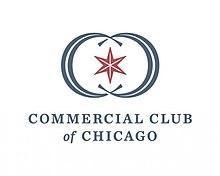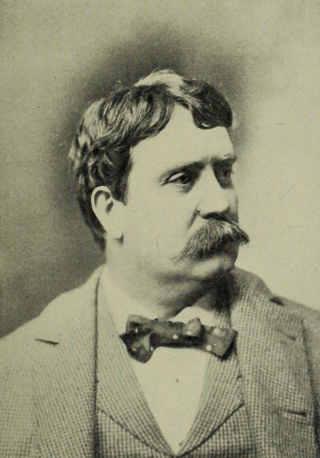
Daniel Hudson Burnham was an American architect and urban designer. A proponent of the Beaux-Arts movement, he may have been, "the most successful power broker the American architectural profession has ever produced."

The City Beautiful movement was a reform philosophy of North American architecture and urban planning that flourished during the 1890s and 1900s with the intent of introducing beautification and monumental grandeur in cities. It was a part of the progressive social reform movement in North America under the leadership of the upper-middle class concerned with poor living conditions in all major cities. The movement, which was originally associated mainly with Chicago, Cleveland, Detroit, Kansas City and Washington, D.C., promoted beauty not only for its own sake, but also to create moral and civic virtue among urban populations.
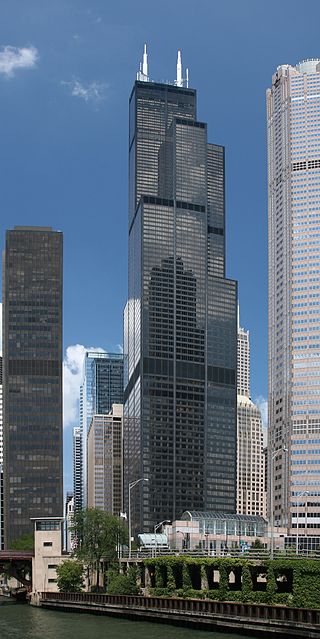
The buildings and architecture of Chicago reflect the city's history and multicultural heritage, featuring prominent buildings in a variety of styles. Most structures downtown were destroyed by the Great Chicago Fire in 1871.
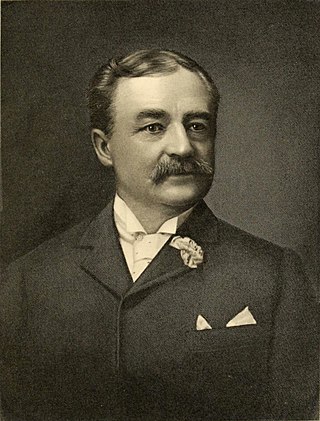
Aaron Montgomery Ward was an American entrepreneur based in Chicago who made his fortune through the use of mail order for retail sales of general merchandise to rural customers. In 1872 he founded Montgomery Ward & Company, which became nationally known.
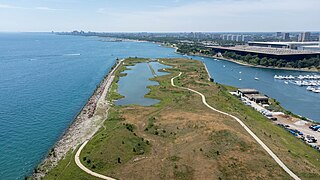
Northerly Island is a 119-acre (48 ha) human-made peninsula and park located on Chicago's Lake Michigan lakefront. Originally constructed in 1925, Northerly Island was the former site of the Century of Progress world's fair and later Meigs Field airport and, since Meigs Field's closure, has been a recreational area part of Chicago's Museum Campus. It is the site of the Adler Planetarium, the Huntington Bank Pavilion, the Northerly Island Natural Area, the 12th Street Beach and numerous art installations. Per its name, Northerly Island was constructed as an island, but is connected to the lakefront by a causeway at the northern end carrying Solidarity Drive to the planetarium.

John Graves Shedd was the second president, and chairman of the board, of Marshall Field & Company.
Dan Rutherford is an American politician who served as the 73rd Treasurer of Illinois from 2011 to 2015. A member of the Republican Party, he previously was the Illinois State Senator from the 53rd district from 2003 to 2011 and a member of the Illinois House of Representatives from 1993 to 2003.

The Reliance Building is a skyscraper located at 1 W. Washington Street in the Loop community area of Chicago, Illinois. The first floor and basement were designed by John Root of the Burnham and Root architectural firm in 1890, with the rest of the building completed by Charles B. Atwood in 1895. It is the first skyscraper to have large plate glass windows make up the majority of its surface area, foreshadowing a design feature that would become dominant in the 20th century.

Dwight Heald Perkins was an American architect and planner.

Willis Jefferson Polk was an American architect, best known for his work in San Francisco, California. For ten years, he was the West Coast representative of D.H. Burnham & Company. In 1915, Polk oversaw the architectural committee for the Panama–Pacific International Exposition (PPIE).
The Civic Federation is a Chicago-based non-partisan research organization focused on governments in the Chicago area and the state of Illinois. The Civic Federation's mission is to help local and state governments reduce their costs and improve public services by "Promoting opportunities to reform local tax structures; guarding against wasteful expenditure of public funds; and serving as a technical resource to public officials and opinion leaders through non-partisan tax and fiscal research." The Federation was founded to fight corruption, government subsidies, high taxes, and unneeded public enterprise. However it also wanted government to solve the problems of the metropolis. The newspapers adopted Mugwumpery as a way of building support for municipal reform among working-class voters in the late 19th century and the Progressive Era.

Graham, Anderson, Probst & White (GAP&W) was a Chicago architectural firm that was founded in 1912 as Graham, Burnham & Co. This firm was the successor to D. H. Burnham & Co. through Daniel Burnham's surviving partner, Ernest R. Graham, and Burnham's sons, Hubert Burnham and Daniel Burnham Jr. In 1917, the Burnhams left to form their own practice, which eventually became Burnham Brothers, and Graham and the remaining members of Graham, Burnham & Co. – Graham, (William) Peirce Anderson, Edward Mathias Probst, and Howard Judson White – formed the resulting practice. The firm also employed Victor Andre Matteson.
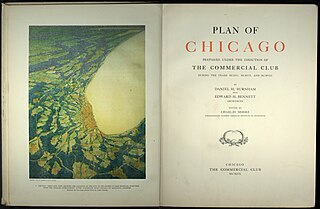
The Burnham Plan is a popular name for the 1909 Plan of Chicago, co-authored by Daniel Burnham and Edward H. Bennett and published in 1909. It recommended an integrated series of projects including new and widened streets, parks, new railroad and harbor facilities, and civic buildings. Though only portions of the plan were realized, the document reshaped Chicago's central area and was an important influence on the new field of city planning.

Charles Henry Wacker, born in Chicago, Illinois, was a German American businessman and philanthropist. He was vice chairman of the general committee of the Commercial Club of Chicago, and in 1909 was appointed chairman of the Chicago Plan Commission by Mayor Fred A. Busse. As commission chairman from 1909 to 1926, he championed the Burnham Plan for improving Chicago. His work to promote the plan included addresses, obtaining wide publicity from newspapers, and publishing Wacker's Manual of the Plan of Chicago as a textbook for local schoolchildren.
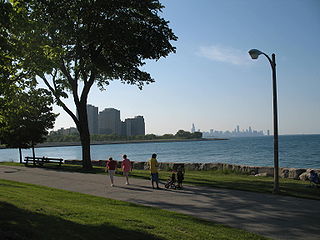
Burnham Park is a public park located in Chicago, Illinois. Situated along 6 miles (9.7 km) of Lake Michigan shoreline, the park connects Grant Park at 14th Street to Jackson Park at 56th Street. The 598 acres (242 ha) of parkland is owned and managed by Chicago Park District. It was named for urban planner and architect Daniel Burnham in 1927. Burnham was one of the designers of the 1893 World's Columbian Exposition.

The Union League Club of Chicago is a prominent civic and social club in Chicago that was founded in 1879. Its second and current clubhouse is located at 65 W Jackson Boulevard on the corner of Federal Street, in the Loop neighborhood of Chicago. The club is considered one of the most prestigious in Chicago, ranking fourth in the United States and first in the Midwest on the Five Star Platinum Club list.
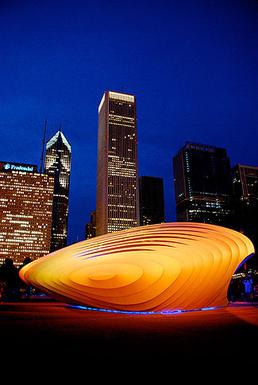
The Burnham Pavilions were public sculptures by Zaha Hadid and Ben van Berkel in Millennium Park, which were located in the Loop community area of Chicago, Illinois. Both pavilions were located in the Chase Promenade South. Their purpose was to commemorate the 100th anniversary of Daniel Burnham's Plan of Chicago, and symbolize the city's continued pursuit of the Plan's architectural vision with contemporary architecture and planning. The sculptures were privately funded and reside in Millennium Park. The pavilions were designed to be temporary structures.

Bruce Vincent Rauner is an American businessman, philanthropist, and politician who served as the 42nd governor of Illinois from 2015 to 2019. A member of the Republican Party, he previously served as the chairman of R8 Capital Partners and chairman of the Chicago-based private equity firm GTCR.
Tyrone Clarence "Ty" Fahner is an American lawyer and politician. A member of the Republican Party he served as Illinois Attorney General from 1980 until 1983. He was appointed to the position by Governor James R. Thompson after the incumbent, William Scott, had been disqualified from office after being convicted of a tax crime.
The City Club of New York is a New York City–based independent, not-for-profit organization.
